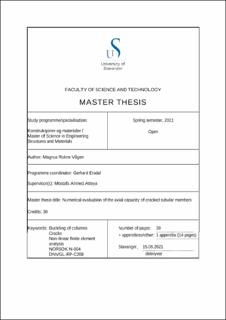| dc.description.abstract | The objective of this thesis is to evaluate the axial capacity of cracked tubular elements analytically and numerically and compare these with laboratory tests. The laboratory tests have been performed by a different student and the experiments as such is not a part of this master thesis work.
The analytical hand calculations have been performed according to NORSOK N-004 and the numerical finite element analysis have been performed according to DNVGL-RP-C208.
In addition, two literature studies have been performed, one on non-linear finite element analysis and one on buckling of columns.
The numerical model used considers the same geometry used in the experimental work, non-linear stress-strain behaviour, and initial geometric imperfection. Four different models have been created, one undamaged column as a reference model and three damaged columns with different crack sizes. The crack sizes are 12%, 23,5% and 38,5% and the crack size is defined as the percentage of the circumference. Material properties such as Young’s modulus and yield stress are obtained from the experimental work. Three types of boundary conditions are used, fixed-hinged, pinned-pinned, fixed-fixed, and the fixed-hinged boundary conditions related to the setup in the experimental test machine. Pinned-pinned and fixed-fixed are related to the buckling shape. The comparison between the experimental work and the fixed-hinged analysis has a good match in the calculated axial capacity, and its 2% – 7% differences in the capacity
The same four models that were used in the numerical model are used in the analytical hand calculations. The analytical hand calculations are performed by NORSOK N-004 and give an axial capacity of 13% lower than the experimental work for an undamaged column. This is more or less the same when the analytically calculations are compared with the non-linear finite element analysis.
The results show that there is a good match between the experimental work and the non-linear analysis. Some bigger differences are found in the comparison between the analytical results and the experimental work. This project ends with suggestions for further works. | |
